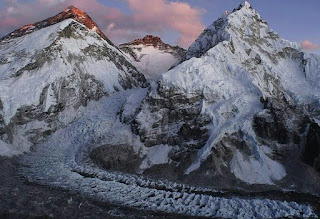Sagarmatha National Park:Home of Mount Everest

Its said that nothing can match the walker’s sense of thrill and excitement when they explore Sagarmatha National Park by foot.
 |
| Sagarmatha National Park Under Mount Everest |
Located in the north east of Kathmandu in the Province 1 of eastern Nepal,Sagarmatha National Park is World Heritage Site enlisted by UNESCO with an exceptional area with dramatic mountains, glaciers, deep valleys and seven peaks other than Mount Sagarmatha over 7,000 m and home of several rare mountain species like red panda and snow leopard along with unique Sherpa culture.
 |
| Location of SNP IN Nepal |
How to reach Sagarmatha National Park?
 |
| Namche Bazaar Under Milky Way |
Namche Bazzar is the visitor's centre and entry to Sagarmatha National Park. One can reach Namche Bazaar by following ways:
-Flight to Lukla and two days' walk
-Bus to Jiri and 10 days' walk from there
-Flight toTumlingtar and 10 days' walk
-Bus to Salleri and 5 days' walk
-Flight to Phaplu and 5 days' walk
Facts About Sagarmatha National Park:
1.Sagarmatha National Park is the world's highest national park enlisted in World Heritage Site by UNESCO and home of Mount Everest.The Word 'Sagarmatha' is made of 2 words 'Sagar' meaning sky and 'Matha' meaning forehead.In Tibetan language,Its called Chomolungma meaning Mother of the world.
 |
| Mount Everest (Sagarmatha) |
2.Sagarmatha national park borders Tibet in north by Himalayas and covers an elevation from 2845m to worlds highest point 8848m.Other peaks above 7000m are Lhotse, Cho Oyu, Thamserku, Nuptse, Amadablam and Pumori.
 |
| Khumbu glacier |
The park contains the upper catchment areas of the Dudh Kosi river, Bhotekoshi river basin and the Gokyo Lakes and major glaciers Khumbu,Imza,Ngozumpa and Nangpa.
 |
| Bhotekoshi River |
3. The park's visitor centre is located at the top of a hill in Namche Bazaar, where a company of the Nepali Army is stationed for protection of the park. The park's southern entrance is a few hundred metres north of Monzo at 2,835 m (9,301 ft), a one-day trek from Lukla.
 |
| Namche Bazaar |
 |
| Nepal Army Patrolling In Park |
4. The protected area has been identified as an Important Bird Area by Bird Life International and is included in the Sacred Himalayan Landscape.The declaration of the high altitude Gokyo Lakes as a RAMSAR site in 2007 is additional recognition of the value addition of the area .
 |
| Gokyo lake |
5. The forests provide habitat to about 118 species of birds, including Himalayan monal,Himalayan vulture,blood pheasant, red-billed chough, and yellow-billed chough. Sagarmatha National Park is also home to a number of rare mammal species, including musk deer, snow leopard, Himalayan black bear and red panda. Himalayan thars, langur monkeys, martens and Himalayan wolves are also found in the park.
 |
| Snow Leopard in SNP |
 |
| Lhopophopus(Danphe,National Bird Of Nepal)in SNP |
 |
| Red Panda in SNP |
 |
| Himalayan Vulture in SNP |
 |
| Himalyan Musk Deer in SNP |
Flora like Rhododendrons,pine,junipers are found in the park.Plants cease to grow at about 5,750 m , because this is the permanent snow line in the Himalayas.
 |
| Rhododendron(Laliguras,National Flower of Nepal) in SNP |
6. The Tibetan Buddhist Sherpas(about 6000) have inhabited the region encompassing the Sagarmatha National Park for the last four centuries.
 |
| Buddhist Monastery and Homes of Sherpas in SNP |
Their unique culture and religion has survived to this day and The conservation oriented Sherpa culture is the backbone for the conservation of biodiversity in the Khumbu region.
 |
| Sherpa Ladies In SNP |
 |
| Sherpas rearing Yak in SNP |
7. The Sherpas have become famous for their innate mountaineering abilities and expertise as a result of years of living at high altitudes and navigating through the region. They were, and still are, instrumental in any trek and climb in the park as they have accompanied almost every successful summit to the peak of Everest. It is widely believed that they have a genetic adaptation from living in such high altitudes that make them naturally better at climbing and coping in the extreme high altitudes encountered on a climb.
 |
| Tenjing Norgay Sherpa:First Person in the world to Conquer Mt.Everest(with Edmund Hilliary) |
 |
| Pasang Lhamu Sherpa:First Lady of Nepal to conquer Mt.Everest |
 |
| Angrita Sherpa(Snow leopard):Guiness book world recorder for successful climbing of Mt Everest 10 times wothout use of supplement oxygen |
 |
| AppaSherpa(Super Sherpa):Guiness Book world recorder for successful ascent of Mt Everest 21 times |
8. Almost all the park is covered by high speed mobile connection and Wi-Fi is commonplace in the tea houses and restaurants, even at the highest altitudes.
 |
| World's first tweet from summit of Mt.Everest |
9. Kala Patthar, located within Sagarmatha National Park is the closest viewpoint of Mount Everest. Located at 5545 m, one needs to experience a steep ascend before reaching this mesmerizing spot.
 |
| View from Kalapatthar |
10.Situated within the Sagarmatha (Everest) National Park in Nepal, Hotel Everest View(opened in 1971) has been listed on the Guinness Book of World Records (2004) as the Highest Placed Hotel in the world at 13000ft.The hotel offers a 360 degree view of the awe inspiring peaks. With a view of Mt. Everest from every room, visitors can immerse in this mesmerizing scene in luxury.
 |
| Hotel Everest View satellite image |
 |
| View from Room of Hotel Everest View |
11. In December, Astronaut Randy Bresnik spent 4 days capturing and sharing images of Mt. Everest at different angles from the International Space Station. This are the selection of his shots.
 |
| Himalayas from space |































Gokyo ri trek in the Sagarmatha National Park offers one of the best panoramic views in the entire Sagarmatha Zone.
ReplyDelete